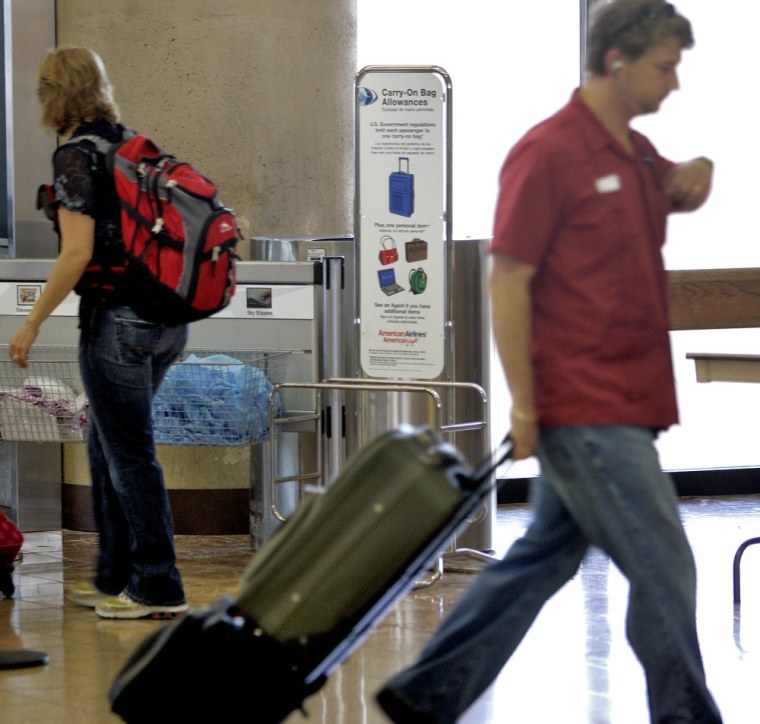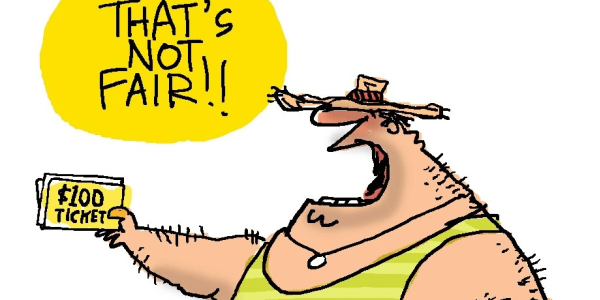As president and CEO of bag manufacturer Skooba Design Inc., Michael Hess is both a frequent flier and an inveterate observer of his fellow travelers’ approach to baggage.
“People are schlepping their bags through security; they’re bringing more of them on the plane; they’re hoping to gate-check them,” he said after getting off a plane at the Rochester airport in upstate New York last week. By the time people actually board, he added, “It’s anarchy.”
It’s also a sign of the times as airlines report record revenues from baggage fees, travelers try to avoid paying them and everybody braces for a busy holiday season.
$2.5 billion and counting
According to just-released figures from the Department of Transportation, the nation’s top 20 airlines took in $2.56 billion in baggage during the first nine months of the year. Since then, they’ve almost certainly topped the $2.7 billion that they earned during all of 2009.
Clearly, the airlines are not about to give up that kind of money — ancillary fees play a major role in the industry’s recent return to profitability — but there is a silver lining. Chalk it up to better handling procedures or fewer bags being checked, but the airlines are doing an increasingly good job of managing the bags that come down the belt.
In October, the nation’s 18 largest airlines mishandled 2.91 bags per 1,000 travelers on domestic flights. That was a 17 percent improvement over 2009 and a 45 percent improvement over 2007, the year before most airlines began charging baggage fees. (In airline parlance, a bag is “mishandled” when it’s lost, damaged, delayed or pilfered.)
Much of the improvement, say airline representatives, is due to improved baggage-handling procedures. At American, employees now use barcode scanners and real-time data collection to improve delivery to connecting flights, a major vector for baggage malfunctions. According to spokesman Tim Smith, 99.4 percent of all checked bags arrive at the destination on the same flight as the customer.
Improved baggage operations is also the reason Alaska Airlines enhanced its baggage-guarantee program earlier this year. Passengers whose bags don’t show up within 20 minutes (previously 25 minutes) receive a $20 voucher for a future flight or 2,000 frequent flier miles. According to Diana Shaw, managing director of the carrier’s Seattle hub, only two to three percent of customers have filed claims.
Slideshow 6 photos
Airline fees get silly
Then, too, many airlines are reporting fewer bags being checked overall. “Prior to checked bag charges, we were averaging about 1.1 to 1.2 checked backs per customer,” said Smith. “Today it is approximately 1.0 or just below.” As with other carriers, the biggest drop has been in the number of second bags being checked.
Presumably, some travelers have learned to travel lighter, although flight attendants and other frequent fliers suspect those previously checked bags are turning up somewhere else.
Crunch-time in the cabin
Sara Keagle, a Houston-based flight attendant who blogs at TheFlyingPinto.com, has certainly noticed an increase in carry-on baggage since the airlines starting charging. “It’s especially difficult in the winter months because people have bulky coats that they shove into the overhead bins making them look full before all the actual bags have been stowed.”
An Alaska Airlines flight attendant, who didn’t want his name published because he wasn’t authorized to speak to the media, expressed sympathy for later-boarding passengers who arrive only to see flight attendants slamming the last full overhead bins shut: “People have their prescriptions and their computers in their carry-on bags. They don’t want to dig it all out or send it below with everything inside.”
Such situations are only exacerbated by high load factors, the proliferation of regional jets with pint-sized overhead bins and the fact that passengers routinely disregard the one bag, one personal item rule. “Sometimes,” said the Alaska Airlines flight attendant, “I’ll see a passenger with three bags and I’ll wonder, how did they get down here?
Probably by ignoring the increasingly insistent gate-area announcements regarding carry-on bags, challenging already time-pressed gate agents and, as Skooba Design's Hess says, “acting like they’re the only ones on the plane.” In fact, as angry as some passengers are about baggage fees, it’s often their fellow passengers’ behavior that really ticks them off.
“I saw a guy jumping up and down on his bag trying to get it to fit in the sizer,” said John Caldwell, a Washington, D.C.-based lawyer. “When it didn’t fit, he carried it on anyway. They ended up gate-checking it for him at no cost. That’s a rip-off.”
“I see the most enormous cases going on the plane,” echoed communications professional Sally Treadwell of Boone, N.C. “I used to wait to board until the absolute last minute so that I could continue walking around the terminal. Now, however, I have to get on the plane fast in order to claim a small segment of overhead compartment for my MacBook Air and overnight essentials.”
Unfortunately, and with Christmas right around the corner, the situation is unlikely to get better any time soon. “There’s just so much animosity,” said Hess, who blames both the airlines and passengers for the contentious state of affairs. “It’s a customer service business, so the onus is on the airlines to make it as pleasant as possible. Unfortunately, passengers don’t make it easy for them to do that.”

